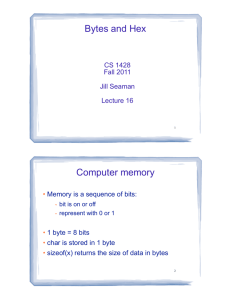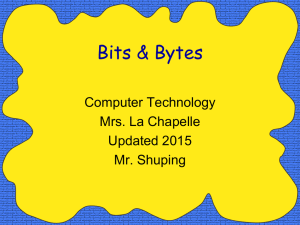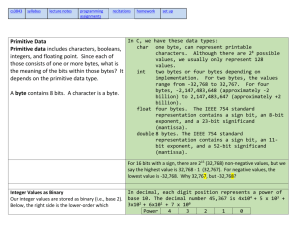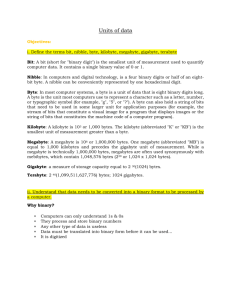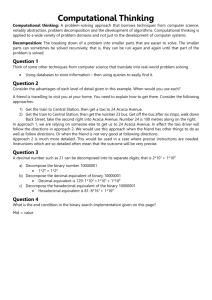Primitive Data
advertisement
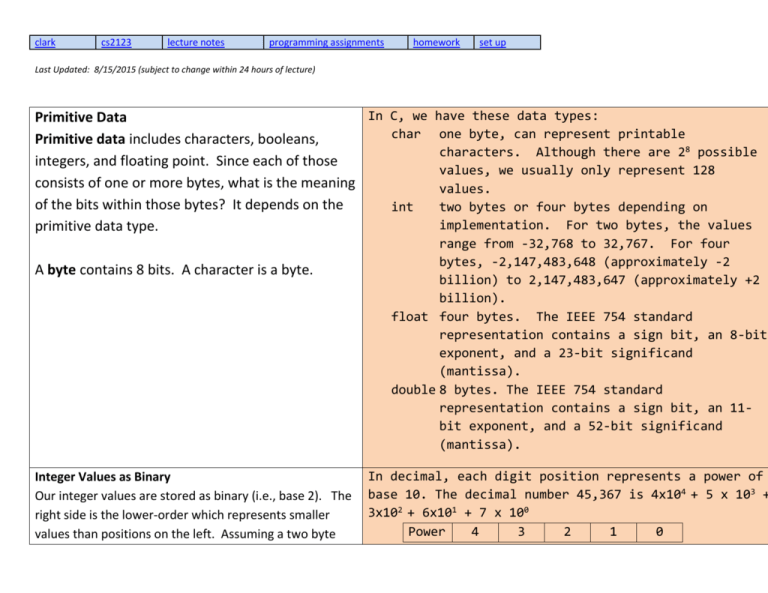
clark cs2123 lecture notes programming assignments homework set up Last Updated: 8/15/2015 (subject to change within 24 hours of lecture) In C, we Primitive Data char Primitive data includes characters, booleans, integers, and floating point. Since each of those consists of one or more bytes, what is the meaning of the bits within those bytes? It depends on the int primitive data type. A byte contains 8 bits. A character is a byte. Integer Values as Binary Our integer values are stored as binary (i.e., base 2). The right side is the lower-order which represents smaller values than positions on the left. Assuming a two byte have these data types: one byte, can represent printable characters. Although there are 28 possible values, we usually only represent 128 values. two bytes or four bytes depending on implementation. For two bytes, the values range from -32,768 to 32,767. For four bytes, -2,147,483,648 (approximately -2 billion) to 2,147,483,647 (approximately +2 billion). float four bytes. The IEEE 754 standard representation contains a sign bit, an 8-bit exponent, and a 23-bit significand (mantissa). double 8 bytes. The IEEE 754 standard representation contains a sign bit, an 11bit exponent, and a 52-bit significand (mantissa). In decimal, each digit position represents a power of base 10. The decimal number 45,367 is 4x104 + 5 x 103 + 3x102 + 6x101 + 7 x 100 Power 4 3 2 1 0 representation of an integer: Decimal Value Two Byte Binary Representation 00000000 00000001 1 00000000 00000010 2 00000000 00000011 3 00000000 00000100 4 00000000 00000101 5 00000000 00001000 8 00000000 00001001 9 00000000 00001010 10 00000000 00010000 16 00000000 00100000 32 00000000 01000000 64 00000000 ? 100 00000000 10000000 128 00000001 00000000 256 Adding Positive Binary Values In decimal, we add values in the 1s position (zero power), possibly carry, and then add values in the tens position (1 power), possibly carry, and so on. In binary, we add the bits in the zero power position, possibly carry, and then add the bits in the one power, possibly carry, and so on. Exercise: Add 15 and 7; Add 30 and 20. Digit 4 5 3 6 7 In binary, each bit position also represents a power, but of base 2. The value 21 is 16 + 4 + 1. Shown with powers of base 2, that is 1x24 + 0x23 +1x22 + 0x21 + 1x20. Power 4 3 2 1 0 Binar 1 0 1 0 1 y Decim 16 4 1 al Add 21 and 12. 21 is 00000000 00010101 12 is 00000000 00001100 adding 00000000 00100001 Note that it carried in the powers 2, 3, and 4. Add 15 and 7: Representing Negative Numbers Instead of simply using one bit for a sign, negative numbers are represented using two's complement. This makes it easier to add or subtract values. 15 is 00000000 7 is 00000000 adding 00000000 Add 30 and 20: 30 is 00000000 20 is 00000000 adding 00000000 We already know what 12 is 1's comp is Add 1 2's comp is ? ? ? ? ? ? 12 is 00000000 11111111 00000000 11111111 00001100 11110011 00000001 11110100 (this is -12) We can get the two's complement of a binary value by 1. Take its one's complement (simply change all 0s to 1s and all 1s to 0s). 2. Add 1 to the result. If we add 23 and -12 (i.e., subtract 12 from 23): 23 is 00000000 00010111 -12 is 11111111 11110100 adding 00000000 00001011 (the last carry falls off) Exercise: show -20 and -7 To get -7: 7 is 00000000 00000111 1's comp is 11111111 ? add 1 00000000 00000001 2's comp is ? (this is -7) To get -20 20 is 00000000 ? 1's comp is 11111111 ? 2's comp is ? (this is -20) Subtract 7 from 15 15 is 00000000 ? -7 is 11111111 11111001 result ? (this is 8) Subtract 20 from 15 15 is 00000000 ? Exercises: subtract 7 from 15. subtract 20 from 15. -20 is ? ? (what number is that? 00000000 00000100 (1's comp) 00000000 00000101 (so that was -5 since this is 5) Hexadecimal Data is represented as hexadecimal (base 16) values to simplify interpretation of bit patterns. An hexadecimal value represents 4 bits. Decimal Binary Hexadecimal Value Value 0 0000 0 1 0001 1 2 0010 2 3 0011 3 4 0100 4 5 0101 5 6 0110 6 7 0111 7 8 1000 8 9 1001 9 10 1010 A 11 1011 B 12 1100 C 13 1101 D 14 1110 E 15 1111 F Characters For the USA, there are two standard encoding of 8 bit characters: EBCDIC - Extended Binary Coded Decimal Interchange Code is mainly used on IBM mainframe computers. It descended from punch card 6 bit representations. ASCII - American Standard Code for Information Interchange has What is each of the following bit patterns in hex? 1100 1001 is C9 1101 0010 is ? 0100 1010 is ? 0101 0011 is ? Letter ASCII Decima l A 65 B 66 C 67 ASCII (Hex) EBCDIC (HEX) 41 42 43 C1 C2 C3 become the more dominant encoding. Do you notice anything that might be annoying about the EBCDIC value sequence? Printable Character Representations of Numbers D E F G H I J K L M N O P Q R S T U V W X Y Z Number 68 69 70 71 72 73 74 75 76 77 78 79 80 81 82 83 84 85 86 87 88 89 90 ASCII (Hex) 0 1 2 3 4 5 30 31 32 33 34 35 44 45 46 47 48 49 4A 4B 4C 4D 4E 4F 50 51 52 53 54 55 56 57 58 59 5A EBCDI C (Hex) F0 F1 F2 F3 F4 F5 C4 C5 C6 C7 C8 C9 D1 D2 D3 D4 D5 D6 D7 D8 D9 E2 E3 E4 E5 E6 E7 E8 E9 6 7 8 9 Converting a Single Numeric Character to a Number We can simply subtract the character '0' from it. int ivalue; char cvalue; // suppose cvalue contains a printable numeric character ivalue = cvalue - '0'; 36 37 38 39 F6 F7 F8 F9
